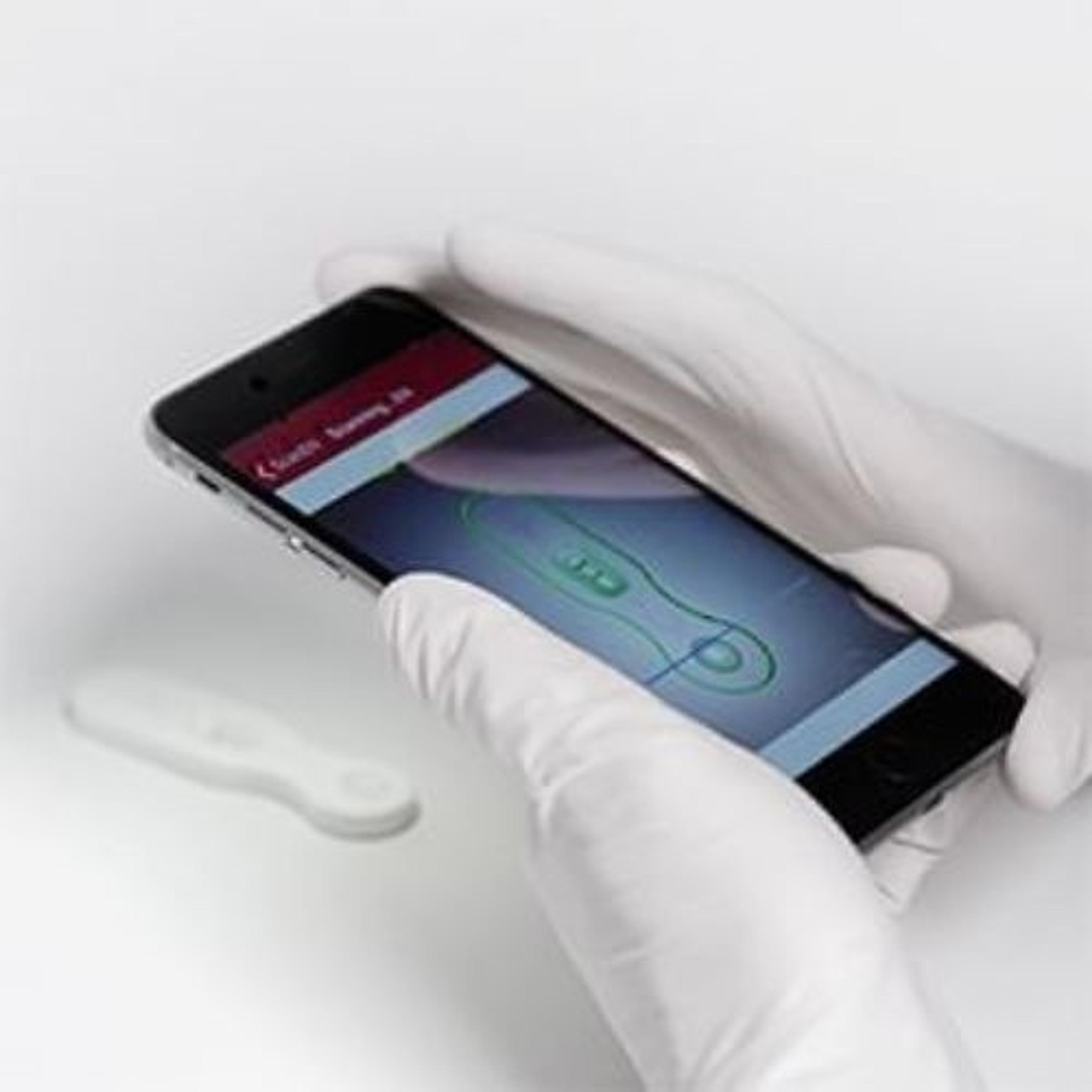Mobile app transforms your smartphone into a diagnostic tool
Discover how a smartphone-based diagnostic platform is democratizing point-of-care testing away from the clinic into a home testing setting
7 Nov 2023

Due to increasing pressures on primary care settings across the globe, access to clinicians is becoming increasingly difficult. To help free up clinicians’ time and resources and ensure patients still have access to relevant testing, healthcare professionals are now looking towards self-testing as a solution.
In this SelectScience® interview, we speak with Dr. Neil Polwart, Group Head of Mobile at BBI Solutions, about an innovative technology that transforms a patient’s smartphone into a mobile diagnostic tool that can be used with minimal training. Polwart describes how this solution gives patients the confidence to self-test and explains how the platform helps connect patients, doctors, and primary care clinicians as part of a mobile ecosystem.
Current challenges with point-of-care testing in the clinic
One of the challenges with a lot of point-of-care tests is the incubation times needed for a result to appear. “If you think of lateral flow tests for COVID-19, these currently have 15-minute plus incubation times,” explains Dr. Neil Polwart. “With the time constraints faced by clinicians, that's not practical to do in a doctor’s office or an A&E department.”
Due to pressures on primary care systems, getting access to a doctor’s appointment can be challenging, and the need for repeat appointments when tests need to be sent to a lab for analysis is adding to the already high pressures felt by clinicians. “For blood tests, for example, you go to the doctor, they take a blood sample, and then send it off. You then must go back to the doctor to get the results and decide on treatment,” says Polwart. “If you could have done that test at home, you could turn up at the doctors with the result, and the doctor could then spend time discussing the results with the patient. Moving beyond the clinic into self-testing is really where we see the Novarum™ platform having the biggest impact.”
Empowering patients to read and share the results of rapid tests from the point of care
The Novarum™ platform from BBI Solutions transforms a user’s smartphone into an advanced diagnostic tool. “Our core intellectual property is about reading the diagnostic test, making that as easy to do as scanning a QR code,” explains Polwart. “It may be that it’s more important to get a reminder to the patient to do the test, instead of collecting data. So, we tailor the workflow around what the test is, and how it's going to be used.”
The timing of point-of-care tests is often critical with many tests being time sensitive. “With some tests – such as those for COVID-19 – if you leave them only two minutes too long, they'll start to develop a false positive,” says Polwart. “We often build timers in the platform to prevent this.”
What we're doing, is providing confidence to the user, and to the clinician that the test has been done correctly. That allows us to make the shift from testing in a clinical setting to at home.
Dr. Neil Polwart
BBI Solutions
As well as providing accurate short-term timers, Novarum can be built with longer-term testing in mind. “If you must test once a month, it can be difficult to remember to do so,” Polwart explains. “To address this, we can add features such as automatically putting the reminder in your diary on your phone, or having push notifications pop up and remind you to do the test. We build the application together with test developers to ensure that running a test is as easy as possible for the user.”
As well as helping users perform the test itself, Novarum makes it easy for results to be sent to the relevant healthcare professional. “If a doctor has asked you to do the test, you want the result to go back to the doctor. If you have a chronic disease that you're monitoring regularly, perhaps that data must go into a database that can be regularly monitored by a clinician and this is something our app can automate for you,” says Polwart.
For self-testing to be a viable option, both users and clinicians need to have confidence in the results. Novarum incorporates patented image capture technology that removes user bias and is designed to provide confidence in test results. “During the height of the COVID-19 pandemic, what we saw from usability studies was that the public became less confident in others having run a lateral flow test correctly. Nobody has ever measured how good human eyesight is at reading these tests properly which could lead to false reporting of results,” explains Polwart. “It's about giving two people confidence in the test result. One is the user themselves and the other is the clinician that needs that test result.”
Polwart continues, “What we're doing is providing confidence to the user and the clinician that the test has been done correctly. That allows us to make the shift from testing in a clinical setting to at home.”
The benefits of mobile point-of-care testing

Mobile point-of-care testing empowers users to perform testing at home whilst freeing up clinician’s time and is particularly useful for infectious disease monitoring and testing. “If there is another pandemic, we all benefit from this technology,” says Polwart. “Whether it is COVID-19 or flu, these are diseases which people could easily be testing for at home.”
Beyond infectious diseases, the technology can be applied to any point-of-care testing, not only helping reduce the need for repeat doctor appointments but also alleviating any anxiety a patient may feel when waiting to hear back about test results. “If there is a test available, then you could be doing them at home instead of having to make a doctor’s appointment and waiting anxiously until you get the result back,” Polwart states.
Discussing who could benefit from this technology, Polwart points to the trend in providing more than just a qualitative test result. “If we look at pregnancy tests as an example, there is a trend towards not just telling you you're pregnant but telling you how many weeks pregnant you are and quantifying the signal on tests,” states Polwart. “If a test tells you that you've got 10 micrograms of human chorionic gonadotropin (hCG) hormone in your urine that's only useful if you understand what that result means. The app helps the patient and clinician understand the result of a test and plan accordingly.”
The platform also provides benefits to patients with chronic diseases. “One of our first customers developed a test for patients with Crohn's disease and they wanted to use Novarum to see if it was possible to monitor the disease from home,” explains Polwart. “The biomarker that is tested for in patients of Crohn’s disease starts to increase in concentration about three months before you would get a flare-up of the disease. By using the app to monitor this biomarker it allows patients and clinicians to manage the condition more effectively and adjust treatment to help avoid flare-ups.”
The future of smartphone-enabled point-of-care testing
Looking to the future of the Novarum platform, there is the possibility of further tailoring the tests to the patient. “You can potentially change the sensitivity and the specificity of a test depending on the cohort of patients that you're testing,” explains Polwart. “And that means you can move from population-wide testing and population-wide sensitivity and specificity to something that's much more tailored towards the patient.”
This ability to further tailor tests also has applications when tackling infectious disease. “In the middle of a pandemic, you could change the sensitivity and specificity depending on how prevalent the disease is in society at that moment in time,” says Polwart.
With the use of artificial intelligence (AI) becoming more widespread across multiple industries, Polwart concludes with his thoughts on how this may have an impact on smartphone-enabled testing, “I think in the medium term, AI isn't going to change the healthcare world quickly because of the validation required to demonstrate that this will work in a healthcare setting. However, in the future, we could start to see AI applied to the output of tests. With simple Bayesian statistics, the technology already exists and we could start adding that sort of level of sophistication to tests today.”

